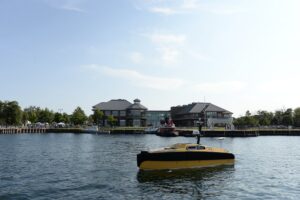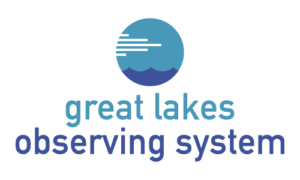For immediate release: Saturday, September 21, 2024
Contact: Samuel Johnson
sam@glos.org
Lakebed 2030 Conference
TRAVERSE CITY, MI – September 17-19, 2024
Industry leaders, Great Lakes organizations, and hydrographic mapping groups gathered at Northwestern Michigan College (NMC) in Traverse City, MI this past week for the Lakebed 2030 Conference. The conference aims to bring together science and research, policy, government, and industry professionals to work towards a strategy, incorporating advanced technologies and a coordinated effort, to acquire, catalog and share new and existing lakebed information.
Keynote speakers and panelists included leaders from National Oceanic and Atmospheric Administration (NOAA), International Joint Commission (IJC), Michigan Technological University (MTU), Great Lakes Observing System (GLOS), among others from marine tech and software companies. These companies showcased their products through technology demonstrations and informational sessions illustrating the present capacity, needs and benefits to accomplish mapping goals by 2030.
“Mapping may seem like an exercise of drawing boundaries that delineate, rather than integrate. Lakebed 2030 manifests the Great Lakes Water Quality Agreement’s purpose to restore and maintain the integrity of the waters of the Great Lakes. This initiative is galvanizing cooperation that transcends boundaries and deploying innovative mapping technologies that will enhance our ability to take the whole-ecosystem approach to protecting our precious shared waters,”
-from IJC Great Lakes Regional Office Director Heather Stirratt who was a featured speaker at this year’s conference.
Also attending the conference were many members of the survey crew from the Lake Superior Plane Search (Mission “Find NCAR”) that was executed Sept 9 – 12. The Smart Ships Coalition led a group of organizations in the search for the 1968 Missing NCAR Plane. The mission doubled as a small area survey demonstration of Ocean Infinity’s Armada 8 (A8), an autonomous surface vehicle (ASV). The survey team successfully surveyed a 29 square mile area of the lake. Initial findings were shared in a presentation at the Lakebed 2030 Conference. The survey data are still being processed and analyzed, yet some targets have been identified for potential recon and investigation missions in the near future.

GLOS worked with Great Lakes Outreach Media group to produce a short film to capture and convey the Lakebed 2030 initiative’s message. GLOS premiered the Lakebed 2030 video at this year’s conference, and it is now available on the the GLOS YouTube channel and Lakebed 2030 website.
Lakebed 2030 is a year-round effort and the attendees will take what they learned at the conference to continue efforts to map more and more of the Great Lakes floor.
For more information:
Great Lakes Observing System
4840 South State

